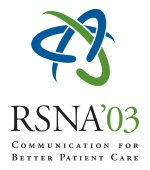Abstract:
HTML
Purpose: To evaluate normal development of fetal renal anatomy on MRI. The purpose is to establish a normal baseline so subtle abnormalities of fetal renal parenchyma can be identified.
Methods and Materials: Retrospective review of consecutive fetal MRI studies performed at a single institution from June 2000 through January 2003. Studies were performed utilizing HASTE sequence with TE=62 in sagittal, coronal, and axial planes. Images were examined to evaluate renal morphology, corticomedullary differentiation, parenchymal signal characteristics, and pelvicalyceal features.
Results: 336 fetal MRI studies were included with a mean gestational age of 23 weeks (range: 20 to 37 weeks). Studies with primary genitourinary tract abnormalities, spinal cord abnormalities, twin gestation, and hydrops were excluded as well as those with isolated renal abnormalities. Some degree of corticomedullary differentiation was visualized as early as 20 weeks. From approximately 20 to 25 weeks, columns of Bertin were visible without a discrete difference between peripheral cortex and medulla. The renal parenchyma was isointense to the placenta. The columns of Bertin were isointense to spinal musculature. At 26 to 30 weeks, there was a distinct corticomedullary junction with development of a peripheral cortical band of low signal that was isointense to muscle. The medullary parenchyma remained isointense to placenta. Fetal lobulations were more apparent, and there was better definition of the renal pelvis and calyces, distinct from parenchyma. By 30 weeks gestation, the MRI features of discrete cortical and medullary zones was well established and stable throughout the remainder of gestation. The only further significant change after 30 weeks was increased renal size with increasing gestational age.
Conclusion: There is a predictable pattern of development of fetal renal anatomy shown with MRI. Corticomedullary differentiation is well defined by 30 weeks gestation. Familiarity with these patterns is important in order to discriminate normal kidneys from those with early dysplastic changes.
Questions about this event email: JOHNSONA@email.chop.edu
Johnson MD, A,
Magnetic Resonance Imaging of the Normal Development of Fetal Renal Anatomy. Radiological Society of North America 2003 Scientific Assembly and Annual Meeting, November 30 - December 5, 2003 ,Chicago IL.
http://archive.rsna.org/2003/3107707.html

